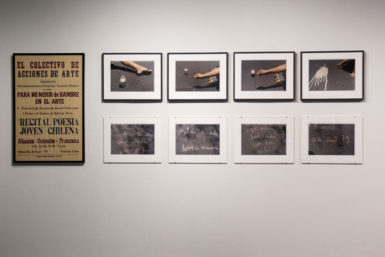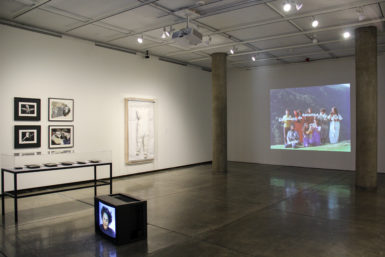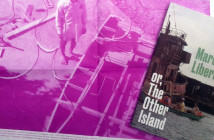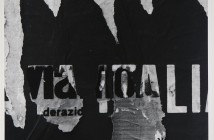In a playful sequence from Cecilia Vicuña’s 1980 film Sol y Dar y Dad, una palabra bailada, a danced word, the viewer’s attention is directed towards a female character, presumably the artist. Her back is leaned against the door of a waiting bus, one leg raised cavalierly onto the stairs. Next, the camera zooms in vertiginously, capturing her hands as she leafs through the pages of a book. The handwriting reads: “la palabra es una pala con alas para abrir la realidad” (the word is a shovel with wings to open reality). Next, children’s hands frame similar words: “Mejor arma que una bala” (better weapon than a bullet). The shift in emphasis makes the phrase sound like a correction. A better weapon, more efficient, perhaps? “La palabra es una arma” (the word is a weapon), the following page enunciates. In the next shot, fingers reach up a sleeve and return the miniature silhouette of a weapon inscribed “Palabrarma” (word-weapon).
If the film is a puzzle, perhaps this clue will lead to a plausible solution. My instinct is turned on its head; the aggressiveness of the pointed gun is infantilized through scale, sedated by translation into two-dimensional space–it’s merely a toy, a cartoon toy! Yet we all know how powerful, searing, and deceptive words can be. This is a protest where dissent is released through motion, catching pedestrians by surprise. The camera points at questioning typographies compressed between the paper ads flanking the streets. Weapon-words are inserted into the layers of the city, carried on banners, addressing the crowds of Bogotá. References to other streets, in other cities, and to events running parallel emerge. The torn section of a poster pops up, like a refrain, Para no morir de hambre en el arte (So as Not to Die of Hunger in Art), onto the prepared surfaces of décollage.

Cecilia Vicuña, Sol y Dar y Dad, una palabra bailada, a danced word (still), 1980. From the series Palabrarmas, Bogotá. Filmed in 16 mm, transferred to digital, (color, silent), 4:3, 4 min. Courtesy of the Artist.
Vicuña began working on her “Palabrarmas” project (of which this film is part) soon after the military coup in Chile on September 11, 1973. Sol y Dar y Dad was made in relation to the Santiago-based artist group CADA (Colectivo Acciones de Arte), whose 1979 Para no morir de hambre campaign led to the production of some of their most well-known, and perhaps most provocative, self-titled acciones de arte (art actions). The group began its activity following the installation of the Pinochet regime, and was at the forefront of the escena de avanzada, a generation of socially committed and politically invested art-makers, as characterized by critic Nelly Richard. CADA staged numerous contestatory public actions, “interventions in everyday life,” strategies designed to draw attention to the political situation in Chile, and the government’s abuse of human rights. Vicuña’s film expresses the sense of urgency that many artists from that generation felt in relation to the unfolding of contemporary events. Furthermore, it conveys a powerful desire to participate, to contribute, and to partake, even from exile. In Chile and beyond, artists sought to create synchronicities, tightening physical networks and expanding them via technology, seeking to counter the claustrophobic inwardness of repressive regimes.

Performance photography, Carmen Beuchat, Two not One II, 2016, Embodied Absence: Chilean Art of the 1970s Now, Carpenter Center for the Visual Arts, Sert Gallery, Oct 27, 2016–Jan 8, 2017. Courtesy Carpenter Center for the Visual Arts, Harvard University.
Mandated by such immediate circumstances, yet also in response to greater trends in an international context, Chilean artists and practitioners developed strategies for engaging with their audiences more directly, opting for interventions in public space as an alternative form of mark-making, resisting traditional, gallery-bound formats. Of these actions and performances, many survive only in fragments through various forms of documentation: photographic, film/video, text, and sound. Mindful of such fragility, yet inspired by their lasting influence, Embodied Absence: Chilean Art of the 1970s Now places a concise, yet well-matched, group of projects from this era in conversation. The installation at the Carpenter Center for the Visual Arts (CCVA) functions as both conduit and envelope for the rapprochement of these terms, although with an important difference: the frame of reference is that of the present, as several of the artworks on view were reconstituted in their aftermath, while some performance pieces have been commissioned anew. Liz Munsell, the exhibition’s curator, uses the term “reconstruction” in relation to Carmen Beuchat’s dance performance commissioned by the CCVA–a “variation” of the artist’s 1975 piece Two not One. In addition, a “performance-lecture” by CADA member Raúl Zurita and Cristóbal Lehyt (born the year of the coup) was organized. As in several other instances in the exhibition, these two artists’ biographies span the period under consideration to the present, drawing tributary lines between memory and lived experience.

Installation view, Embodied Absence: Chilean Art of the 1970s Now, Carpenter Center for the Visual Arts, Sert Gallery, Oct 27, 2016–Jan 8, 2017. Cecilia Vicuña, Vaso de Leche, Bogotá (Glass of Milk, Bogotá), 1979. Courtesy Carpenter Center for the Visual Arts, Harvard University.
Part of the point of the exhibition is to illustrate the inadequacy of current art historical and curatorial models that have, even if unintentionally, served to commodify contemporary practices such as those on view, annulling their political agency and neutralizing their overall affect. To quote Munsell: “materiality and scale prompt a physical relationship with the viewer yet refute the fetishization of the original and the myth of its seamless transference.” I thus read the exhibition as an invocation, one that releases the artworks and artifacts on view into new dialogues and conversations, afterlives of sorts. Indeed, Vicuña’s film already presents a fitting instance of reflection, as it was made in the aftermath of her artist action Vaso de leche, Bogotá (Glass of Milk, Bogotá). The action was one of the multiple interventions planned to take place concurrently in Santiago, Toronto and Bogotá under the banner Para no morir de hambre. The piece also makes an appearance in an installation consisting of a series of eight photographs and a poster produced to promote the day-long event. Here too, the emphasis is on small, yet affirmative gestures: a provoked accident, a glass of milk on a leash, pulled slowly but surely towards a spill. Hunger, real hunger, is not just referenced in the title, but rendered tangible through the consummated act: nothing is left. Many mouths open and close throughout this show, signaling need, yet also desire. Poetry might succeed in providing nourishment for both.

Cecilia Vicuña, Vaso de Leche, Bogotá (Glass of Milk, Bogotá), 1979. Installation of 8 photographs and a letterpress poster on paper. Variable dimensions. Private collection. Courtesy of England & Co. Gallery.
The glass was spilled under a blue sky, a direct reference again to a CADA text which would be read a few days later in a gallery in Santiago, as part of the same series of actions. Perhaps the show is most effective in how it concentrates such moments, both in their lived past and in potential futures: “it’s the same sky and the collective construction of its meaning will also be the construction of the sky in Bolivia, in Paraguay, the sky in Zaire, in Bangladesh, in Greece. It will also be the sky in the U.S., in Nagasaki, in Brazil, in the Soviet Union, in India, in Canada, in Norway, in Mexico.” So the text read: “Some day this life will be a decent life.”
In this coincidence of places, I begin to see other patterns and connections, unfinished threads. Slender arms reach over enigmatic target-like silhouettes in Luz Donoso’s posters, repeated throughout the gallery space and on the Carpenter’s exterior. The gesture comes as a contradiction: is this a reassuring, comforting embrace, or is it an act of restraint? Easily confused as signage within the street vernacular, the hands function equally as indicators. I am reminded of the series of life-size pictures that document Elías Adasme’s 1979-1980 actions To Chile, installed on another gallery wall. Inscribed onto the very surfaces of the city’s streets, the artist’s body registers as an odd, almost uncanny, presence. Here it is, posed like an open question in the most mundane of situations, hung upside-down by a Metro sign with the map of Chile to the side. There again a map of the same territory is projected onto the artist’s skin, like an impermanent tattoo. His spine and the Cordillera de los Andes are almost perfectly aligned. His skin follows the curves of the country’s body, outlined by water.

Installation view, Embodied Absence: Chilean Art of the 1970s Now, Carpenter Center for the Visual Arts, Sert Gallery, Oct 27, 2016–Jan 8, 2017. Floor: Carlos Leppe, Las Cantatrices, 1979. Left: Francisco Copello, Il Gioco dell´Ambiguita (The Ambiguity Game), 1977. Center: Catalina Parra, Imbunche gigante (Giant Imbunche), 2016. Right: Cecilia Vicuña, Sol y Dar y Dad, una palabra bailada, a danced word, 1980. Courtesy Carpenter Center for the Visual Arts, Harvard University.
I am reminded of another effigy, Catalina Parra’s Imbunche gigante (Giant Imbunche), first exhibited in 1977, and remade in 2016. Relating to techniques of the body, to bound bodies or target bodies, the piece captures a great deal of the implications and explications at hand. Here is a violently fragmented body, unabashedly on display. Notice, however, its untainted whiteness, the care with which its edges were sewn, then sealed behind a glass vitrine. Is this a tortured body, a healing body, or the body of a doll? The stitches are reminiscent of the color-rich textiles that waltz between the building’s concrete walls on the ground level, their shadows gravitating towards the floor. The piece is Felipe Mujica and Johanna Unzueta’s The Earth Balances the Extremes (2016). Details of the zigzagging stitches describe geometric forms onto the flexible screens. They, like Beuchat’s dance accessories, may become extensions of bodies–shells or shelters framed by the surrounding architecture of the Carpenter Center.
The exhibition calls on, appeals to, and invokes artworks produced during a period of extremes in Chile, one of great political turmoil, yet also one of great “artistic” and literary ambition. While this may be Chile’s most well-known era abroad, its influence is relativized by work produced in subsequent decades. One can only hope that closer attention will be paid to those practices as well. For now, perhaps viewers will be enticed to contemplate how to proceed from this intersection of roads. Embodied Absence provides a reminder of how essential it is to continue to push against the limits of what is politically and aesthetically possible.


